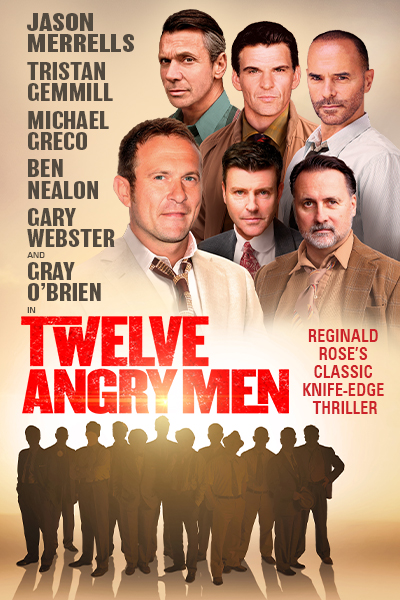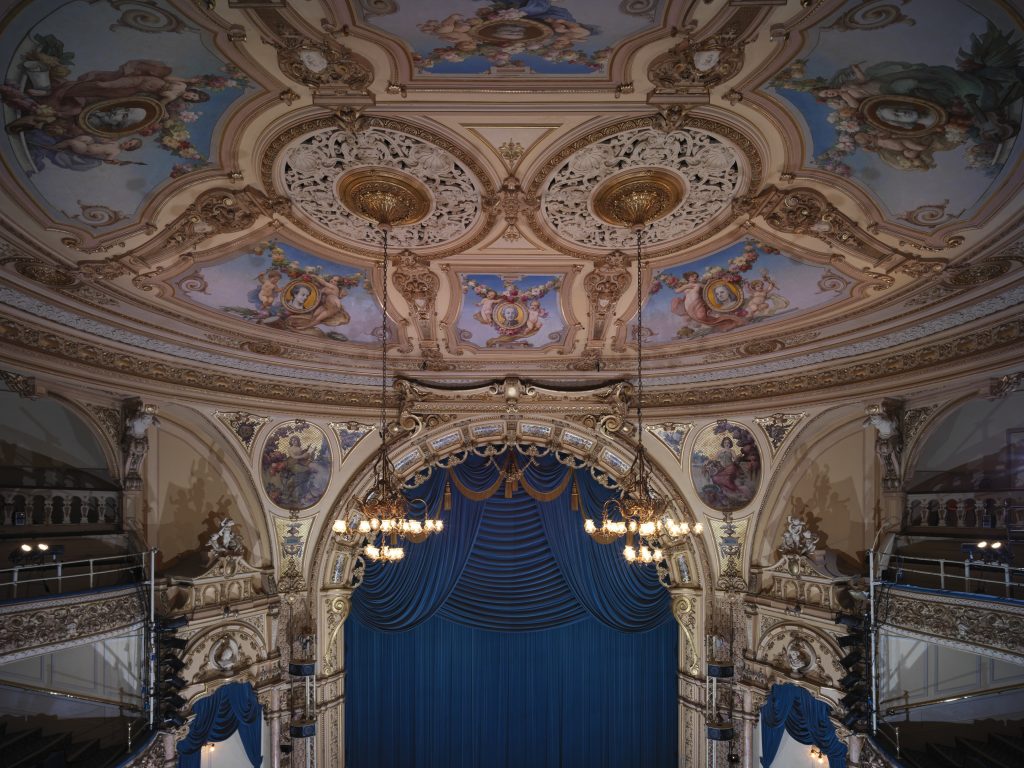
Take a look at: Our Venue | Venue Hire | Frank Matcham | Thomas Sergenson | Our History | Sustainability | Visiting Companies
Our architecture has been described as ‘a masterpiece’. The theatre was designed by renowned architect Frank Matcham (1854-1920). Here you can discover more about its architecture.
Matcham designed or significantly reconstructed over 160 theatres within the British Isles and is Great Britain’s most prolific theatre architect of all time. Furthermore, his theatres are now recognised as being iconic designs which, above all, worked superbly to create evocative performance spaces that are still much loved by the theatre-going public of the twenty-first century.
Blackpool’s Grand was opened on the 23rd July 1894 at a time when theatre building and the work of Frank Matcham was at its height. By the time the first independent Stage Guide and Directory was published in 1912, Blackpool was extremely well provided with theatres. This clearly demonstrates the huge demand for theatre in Blackpool in the early twentieth century.
Inevitably perhaps, Matcham also had a hand in designing and/or remodelling a number of the theatres, including The Tower Circus, The Tower Ballroom, The Tower Tea Rooms, and Her Majesty’s Opera House. It is clear from this list that he was often invited to remodel and rework some of his earlier pieces of work as architectural styles, tastes and theatre ‘fashion’ changed. By 1894, his theatrical stamp was already very clearly and firmly impressed upon the people of Blackpool.
As the most prolific British theatre architect of the day Matcham, during his working career (1873-1913), was able to create and work on over 160 theatres and entertainment buildings the length and breadth of the British Isles. Today, only 24 survive intact, in a recognisable ‘as built’ condition, and some of these are either under threat or disused. These survivors without exception are now recognised and protected as listed buildings. The work of this single man (and, it should be said, his dedicated yet largely anonymous personnel who worked in the practice) created a house style that developed through the years, but was always vibrant, eclectic and above all highly theatrical.
Within a context such as this, it can quite clearly be stated that Blackpool Grand Theatre represents one of the most complete and important Matcham ‘survivors’. The word ‘complete’ is used in this context to define a comprehensive and detailed survival incorporating original decorative glass, door furniture, ironmongery and light fittings etc. The level of surviving detail (which also includes some original soft loose furnishings) raises the importance of the building and provides an exceptional view of what the theatre looked like when it first opened in 1894.
The British Isles once boasted a profusion of theatres, scattered far and wide, in towns, cities, and even villages. Today there is a misconception that all cities and most towns still have an ‘old theatre’ – nothing could be further from the truth. When in 1982 Curtains!!! or A New Life For Old Theatres was published it produced a stark picture of the wanton destruction that had been carried out on Britain’s theatrical heritage: “Eighty-five per cent of the 1,000 Theatre Royals, Grands, Alhambras and Empires, which flourished in Britain between 1900 and 1914 have been destroyed or irretrievably altered. Under a tenth of this marvellous heritage of popular theatres which once enlivened every High Street are still in use as theatres. This leaves some 70 yet to be reawakened – ‘Sleeping Beauties’ spread throughout England, Scotland and Wales.”
This clearly places Blackpool Grand in a national context, and twenty-two years later the situation is even worse – the Royal Opera House, Scarborough (Grade II) was demolished in the last ten years, and other theatres identified as survivors in 1982 have been lost, e.g. Empire Theatre, Longton – burnt down; Dunfermline Opera House – demolished (and its auditorium exported and rebuilt in Florida); Birkenhead Music Hall – demolished; and more recently the Palace & Hippodrome Theatre, Nelson, Lancashire was demolished by an unenlightened Local Authority.
Today, there are only 67 Grade 1 (Grade ‘A’ equivalent in Scotland) listed theatres in the British Isles – these include:
- Theatre Royal, Bristol (1766)
- Theatre Royal, Richmond, North Yorkshire, (1788)
- Theatre Royal, Drury Lane, London, (1811)
- Theatre Royal, Bury St. Edmunds, (1819)
- Theatre Royal, Haymarket, London, (1821)
- Theatre Royal, Newcastle on Tyne (1837, 1900)
- Royal Opera House, Covent Garden, London, (1858)
- Britannia Music Hall, Glasgow, (1869)
- Tyne Theatre and Opera House, Newcastle on Tyne, (1867)
- Theatre Royal, Glasgow, (1869)
- Tivoli Theatre, Aberdeen, (1872, 1897, 1910)
- Royal Lyceum Theatre, Edinburgh, (1883)
- Adelina Patti Private Theatre, Craig-y-Nos, (1891)
- Athenaeum Theatre, Glasgow, (1892)
- Chatsworth House, Private Theatre, (1830, 1897)
- Palace Theatre, Kilmarnock, (1903)
- King’s Theatre, Glasgow, (1904)
- King’s Theatre, Edinburgh, (1906)
- His Majesty’s Theatre, Aberdeen, (1906)
- Eden Court Theatre, Inverness, (1976)
There are one hundred and fifty-four remaining Grade II* or Grade B listed theatres in the British Isles, of which several are post-1950s’ buildings. Of these, numerous can still be described as ‘Sleeping Beauties’ – theatres with a meantime use awaiting to be re-awakened. These include: the Olympia Liverpool, Victoria Pavilion Morecambe, Festival Theatre Cambridge, Palace Theatre Plymouth and the Grand Theatre Llandudno.
Grade I listed buildings (of all types) are of exceptional interest and form only 2.5% of all listed buildings. Grade II* listed buildings form only 5.5%. The majority are made up from Grade II listed buildings which form the remaining 92%.
In 2000, The Theatres Trust published a re-assessment of the theatres first identified in Curtains! Our architecture is defined as a building of specific note and in the grading within the publication receives the highest rating of three-star. The entry for the theatre is worth quoting in part, particularly as it identifies the importance of Matcham’s external elevations.
The fact that Matcham was given an opportunity to develop and express two external elevations is noteworthy, indeed exceptional. Most of his theatres were crammed onto small sites, often with very narrow frontages and relatively modest architectural statements. Yet here in Blackpool, this is Matcham in his pomp, creating a statement in the streetscape, designing a theatre of significance in an expanding and prosperous seaside town.
During the period whilst he was working on the designs and construction of Blackpool Grand, it is interesting to consider what else was being undertaken in parallel:
- 1893: Derby, Grand, alterations
- 1894: Birmingham, Empire Palace
- 1894: Stoke-on-Trent (Hanley), Theatre Royal, major remodelling
- 1894: London, (Hackney), Shoreditch Empire
- 1894: Manchester, Comedy
- 1894: Grand Theatre. Blackpool, listed
- 1895: London (Hammersmith), Lyric Opera House, listed
- 1895: Reading, Royal County
- 1895: Bristol, Prince’s, alterations
Discover more about our architecture on one of our Theatre Tours or Photographic sessions. Search our What’s On for the next date.



















